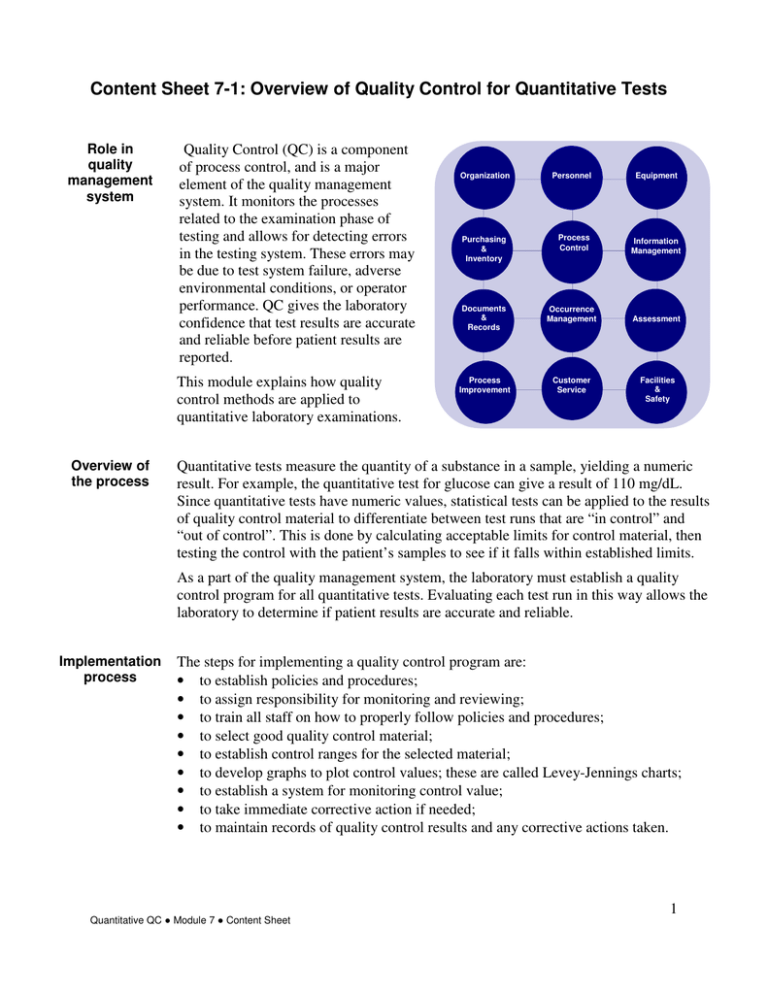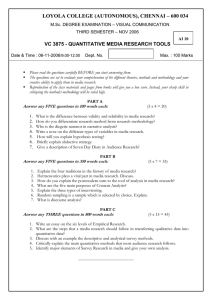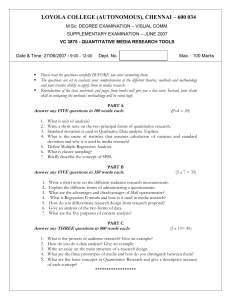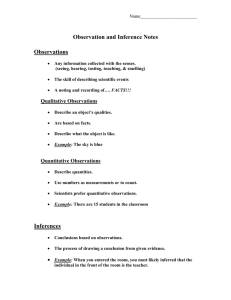Content Sheet 7-1: Overview of Quality Control for Quantitative Tests
advertisement

Content Sheet 7-1: Overview of Quality Control for Quantitative Tests Role in quality management system Quality Control (QC) is a component of process control, and is a major element of the quality management system. It monitors the processes related to the examination phase of testing and allows for detecting errors in the testing system. These errors may be due to test system failure, adverse environmental conditions, or operator performance. QC gives the laboratory confidence that test results are accurate and reliable before patient results are reported. This module explains how quality control methods are applied to quantitative laboratory examinations. Overview of the process Organization Personnel Equipment Purchasing & Inventory Process Control Information Management Documents & Records Occurrence Management Assessment Process Improvement Customer Service Facilities & Safety Quantitative tests measure the quantity of a substance in a sample, yielding a numeric result. For example, the quantitative test for glucose can give a result of 110 mg/dL. Since quantitative tests have numeric values, statistical tests can be applied to the results of quality control material to differentiate between test runs that are “in control” and “out of control”. This is done by calculating acceptable limits for control material, then testing the control with the patient’s samples to see if it falls within established limits. As a part of the quality management system, the laboratory must establish a quality control program for all quantitative tests. Evaluating each test run in this way allows the laboratory to determine if patient results are accurate and reliable. Implementation process The steps for implementing a quality control program are: • to establish policies and procedures; • to assign responsibility for monitoring and reviewing; • to train all staff on how to properly follow policies and procedures; • to select good quality control material; • to establish control ranges for the selected material; • to develop graphs to plot control values; these are called Levey-Jennings charts; • to establish a system for monitoring control value; • to take immediate corrective action if needed; • to maintain records of quality control results and any corrective actions taken. Quantitative QC ● Module 7 ● Content Sheet 1 Content Sheet 7-2: Control Materials Defining control Controls are substances that contain an established amount of the substance being materials tested– the analyte. Controls are tested at the same time and in the same way as patient samples. The purpose of the control is to validate the reliability of the test system and to evaluate the operator’s performance and environmental conditions that might impact results. Differentiating controls and calibrators It is important not to confuse calibrators and control materials. Calibrators are solutions with a specified defined concentration that are used to set or calibrate an instrument, kit, or system before testing is begun. Calibrators are often provided by the manufacturer of an instrument. They should not be used as controls since they are used to set the instrument. Calibrators are sometimes called standards, but the term calibrator is preferred. They usually do not have the same consistency as patients’ samples. Characteristics of control materials It is critical to select the appropriate control materials. Some important characteristics to consider when making the selection. • Controls must be appropriate for the targeted diagnostic test–the substance being measured in the test must be present in the control in a measurable form. • The amount of the analyte present in the controls should be close to the medical decision points of the test; this means that controls should check both low values and high values. • Controls should have the same matrix as patient samples; this usually means that the controls are serum-based, but they may also be based on plasma, urine, or other materials. Because it is more efficient to have controls that last for some months, it is best to obtain control materials in large quantity. Types and sources of control material Control materials are available in a variety of forms. They may be frozen, freeze-dried, or chemically preserved. The freezedried or lyophilized materials must be reconstituted, requiring great care in pipetting in order to assure the correct concentration of the analyte. Control materials may be purchased, obtained from a Quantitative QC ● Module 7 ● Content Sheet 2 central or reference laboratory, or made in-house by pooling sera from different patients. Purchased controls may be either assayed or unassayed. Assayed controls have a pre-determined target value, established by the manufacturer. When using assayed controls the laboratory must verify the value using its own methods. Assayed controls are more expensive to purchase than unassayed controls. When using either unassayed or “in-house” or homemade controls, the laboratory must establish the target value of the analyte. The use of in-house controls requires resources to perform validation and testing steps. An advantage is that the laboratory can produce very large volumes with exact specification. Remember that quality control materials are usually serum-based. Universal precautions should be used when handling. Choosing controls When choosing controls for a particular method, select values that cover medical decision points, such as one with a normal value, and one that is either high or low, but in the medically significant range. Controls are usually available in ‘high’, ‘normal’, and ‘low’ ranges. Shown in the graphic are normal, abnormal high and low, and critical high and low ranges. For some assays, it may be important to include controls with values near the low end of detection. Preparing and storing control material When preparing and storing quality control materials it is important to carefully adhere to the manufacturer’s instructions for reconstituting and for storage. If inhouse control material is used, freeze aliquots and place in the freezer so that a small amount can be thawed and used daily. Do not thaw and re-freeze control material. Monitor and maintain freezer temperatures to avoid degradation of the analyte in any frozen control material. Use a pipette to deliver the exact amount of required diluent to lyophilized controls that must be reconstituted. Quantitative QC ● Module 7 ● Content Sheet 3 Content Sheet 7-3: Establishing the Value Range for the Control Material Assaying control over time Once the appropriate control materials are purchased or prepared, the next step is to determine the range of acceptable values for the control material. This will be used to let the laboratory know if the test run is “in control” or if the control values are not reading properly – “out of control”. This is done by assaying the control material repeatedly over time. At least 20 data points must be collected over a 20 to 30 day period. When collecting this data, be sure to include any procedural variation that occurs in the daily runs; for example, if different testing personnel normally do the analysis, all of them should collect part of the data. Once the data is collected, the laboratory will need to calculate the mean and standard deviation of the results. A characteristic of repeated measurements is that there is a degree of variation. Variation may be due to operator technique, environmental conditions, and the performance characteristics of an instrument. Some variation is normal, even when all of the factors listed above are controlled. The standard deviation gives a measure of the variation. One of the goals of a quality control program is to differentiate between normal variation and errors. Characteristics of repeated measures A few theoretical concepts are important because they are used to establish the normal variability of the test system. Quality control materials are run to quantify the variability and establish a normal range, and to decrease the risk of error. The variability of repeated measurements will be distributed around a central point or location. This characteristic of repeated measurements is known as central tendency. The three measures of central tendency are: • Mode, the number that occurs most frequently. • Median, the central point of the values when they are arranged in numerical sequence. • Mean, the arithmetic average of results. The mean is the most commonly used measure of central tendency used in laboratory QC. Quantitative QC ● Module 7 ● Content Sheet 4 Statistical notations Statistical notations are symbols used in mathematical formulas to calculate statistical measures. For this module, the symbols that are important to know are: ∑ the sum of n number of data points (results or observations) X1 individual result X1 -. Xn X data point 1- n where n is the last result the symbol for the mean. the square root of the data. Mean The formula for the mean is: As an example of how to calculate a mean, consider ELISA testing. The method is to gather data as ratios, add the values, and divide by the number of measurements. Before calculating QC ranges The purpose of obtaining 20 data points by running the quality control sample is to quantify normal variation, and establish ranges for quality control samples. Use the results of these measurements to establish QC ranges for testing. If one or two data points appear to be too high or low for the set of data, they should not be included when calculating QC ranges. They are called “outliers”. Normal distribution • If there are more than 2 outliers in the 20 data points, there is a problem with the data and it should not be used. • Identify and resolve the problem and repeat the data collection. If many measurements are taken, and the results are plotted on a graph, the values form a bell-shaped curve as the results vary around the mean. This is called a normal distribution (also termed Gaussian distribution). The distribution can be seen if data points are plotted on the x-axis and the frequency with which they occur on the y-axis. The normal curve shown (right) is really a theoretical curve obtained when a large number of measurements are plotted. It is assumed that the types of measurements used for quantitative QC are normally distributed based on this theory. Quantitative QC ● Module 7 ● Content Sheet 5 Accuracy and precision If a measurement is repeated many times, the result is a mean that is very close to the true mean. Accuracy is the closeness of a measurement to its true value. Precision is the amount of variation in the measurements. • The less variation a set of measurements has, the more precise it is. • In more precise measurements, the width of the curve is smaller because the measurements are all closer to the mean. Bias is the difference between the expectation of a test result and an accepted reference method. Target illustration The reliability of a method is judged in terms of accuracy and precision. A simple way to portray precision and accuracy is to think of a target with a bull’s eye. The bull’s eye represents the accepted reference value which is the true, unbiased value. If a set of data is clustered around the bull’s eye, it is accurate. The closer together the hits are, the more precise they are. If most of the hits are in the the bull’s eye, as in the figure on the left, they are both precise and accurate. The values in the middle figure are precise but not accurate because they are clustered together but not at the bull’s eye. The figure on the right shows a set of hits that are imprecise. Measurements can be precise but not accurate if the values are close together but do not hit the bull’s eye. These values are said to be biased. The middle figure demonstrates a set of precise but biased measurements. The purpose of quality control is to monitor the accuracy and precision of laboratory assays before releasing patient results. Measures of variability The methods used in clinical laboratories may show different variations about the mean; hence, some are more precise than others. To determine the acceptable variation, the laboratory must compute the standard deviation (SD) of the 20 control values. This is important because a characteristic of the normal distribution is that, when measurements are normally distributed: • 68.3% of the values will fall within -1 SD and +1 SD of the mean • 95.5% fall within -2 SD and +2 SD Quantitative QC ● Module 7 ● Content Sheet 6 • 99.7% fall between -3 SD and +3 SD of the mean. Knowing this is true for all normally shaped distributions allows the laboratory to establish ranges for quality control material. Once the mean and SD are computed for a set of measurements, a quality control material that is examined along with patients samples should fall within these ranges. Standard deviation Standard deviation (SD) is a measurement of variation in a set of results. It is very useful to the laboratory in analyzing quality control results. The formula for calculating standard deviation is: SD = 2 ∑ (x 1 − x ) n −1 The number of independent data points (values) in a data set are represented by “n” Calculating the mean reduces the number of independent data points to n – 1. Dividing by n-1 reduces bias. To better understand the concept of SD, see the example in Annex A, and Activity Sheet 7-1. Calculating acceptable limits for the control The values of the mean, as well as the values of + 1, 2, and 3 SDs are needed to develop the chart used to plot the daily control values. • • To calculate 2 SDs, multiply the SD by 2 then add and subtract each result from the mean. To calculate 3 SDs, multiply the SD by 3, then add and subtract each result from the mean. The data in Annex 7A has a mean of 190.5 and an SD of 2, therefore: + 1 SD is 188.5 - 192.5 + 2 SD is 186.5 - 194.5, and + 3 SD is 184.5 - 196.5. For any given data point 68.3% of will fall between + 1 SD, 95.5% between + 2D, and 99.7% between + 3 SD of the mean. Once these ranges are established, they can be used to evaluate a test run. For example, if you examine a control with your patients’ samples and get a value of 193.5, you know there is a 95.5% chance that it is within 2 SD of the mean. When only one control is used, we consider a examination run to be “in control” if a 7 Quantitative QC ● Module 7 ● Content Sheet value is within 2 SD of the mean. Coefficient of variation The coefficient of variation (CV) is the standard deviation (SD) expressed as a percentage of the mean. CV (%) = SD x 100 Mean The CV is used to monitor precision. When a laboratory changes from one method of analysis to another, the CV is one of the elements that can be used to compare the precision of the methods. Ideally, the value of the CV should be less than 5%. Quantitative QC ● Module 7 ● Content Sheet 8 Content Sheet 7-4: Graphically Representing Control Ranges Using graphs for analysis and monitoring Once the appropriate range of control values has been established, the laboratory will find it very useful to represent the range graphically for the purpose of daily monitoring. The common method for this graphing is the use of Levey-Jennings charts. Developing data for LeveyJennings charts In order to develop Levey-Jennings charts for daily use in the laboratory, the first step is the calculation of the mean and standard deviation of a set of 20 control values as explained in Content sheet 7-3. LeveyJennings chart A Levy-Jennings chart can then be drawn, showing the mean value as well as plus/minus ( + ) 1, 2, and 3 standard deviations (SD). The mean is shown by drawing a line horizontally in the middle of the graph and the SD are marked off at appropriate intervals and lines drawn horizontally on the graph as shown below. This Levey-Jennings chart was developed using 20 repeated measurements of the control value. In order to use the Levey-Jennings chart to record and monitor daily control values, label the x-axis with days, runs, or other interval used to run QC. Label the chart with the name of the test and the lot number of the control being used. Quantitative QC ● Module 7 ● Content Sheet 9 Content Sheet 7-5: Interpreting Quality Control Data Plotting control values A quality control sample tested along with patient’s samples can now be used to determine if daily runs are “in control”. A control sample must be run with each set of patient samples. Run the control and plot it on the Levey-Jennings chart. If the value is within plus or minus 2 SD (+ 2 SD), the run can be accepted as “in-control”. The values on the chart are those run on days 1, 2, and 3 after the chart was made. In this case, the second value is “out-of-control” because it falls outside of 2 SD. When using only one quality control sample, if the value is outside 2 SD, that run is considered “out of control” and the run must be rejected. Number of controls used If it is possible to use only one control, choose one with a value that lies within the normal range of the analyte being tested. When evaluating results, accept all runs where the control lies within + 2 SD. Using this system, the correct value will be rejected 4.5% of the time. In order to improve efficiency and accuracy, a system using two or three controls for each run can be employed. Then, another set of rules can be used to avoid rejecting runs that may be acceptable. These rules were applied to laboratory QC by a clinical chemist named James Westgard. This Westgard Multirule System requires running two controls of different target values for each set of examinations, developing a Levey-Jennings chart for each, and applying the rules. The Westgard Multirule System is covered in the optional material for this module. The use of three controls with each run gives even higher assurance of accuracy of the test run. When using three controls, choose a low, a normal, and a high range value. There are also Westgard rules for a system with three controls. Quantitative QC ● Module 7 ● Content Sheet 10 Detecting error Errors that occur in the testing process may be either random or systematic. With random error, there will be a variation in quality control results that show no pattern. This type of error generally does not reflect a failure in some part of the testing system, and is therefore not like to reoccur. Random error is only a cause for rejection of the test run if it exceeds + 2 SD. Systematic error is not acceptable, as it indicates some failure in the system that can and should be corrected. Examples of evidence of systematic error include: Shifts and trends • Shift–when the control is on the same side of the mean for five consecutive runs. • Trend–when the control is moving in one direction, and appears to be heading toward an out-of-control value. Even when a control value falls within 2 SD, it can be a cause for concern. LeveyJennings charts can help distinguish between normal variation and systematic error. Shifts in the mean occur when an abrupt change is followed by six or more consecutive QC results that fall on one side of the mean but typically within 95% range as if clustered around a new mean. On the sixth occasion this is called a shift and results are rejected. Trends occur when values gradually, but continually, move in one direction over six or more analytical runs. Trends may display values across the mean, or they may occur only on one side of the mean. On the sixth occasion, this is determined to be a trend and results are rejected. The source of the problem must be investigated and corrected before patients’ samples are reported. Measurement uncertainty As variation occurs in measurements, uncertainty exists as to the true value. Uncertainty represents a range of values in which the true value is reasonably expected to lie. In most situations, measurement uncertainty is estimated at “95% coverage.” For most instances, a range of + 2 SD is accepted as measurement uncertainty that is explained by random variation. But the degree of variation also depends on the method used. Methods that are more precise have less uncertainty because the amount of variation included in the 95% limits is smaller. Laboratories should strive to use methods that have a high degree of precision, and always follow standard operating procedures. Quantitative QC ● Module 7 ● Content Sheet 11 Content Sheet 7-6: Using Quality Control Information When QC is out of range Problem solving When the quality control sample that is used in a test run is out of the acceptable range, the run is considered to be “out of control”. When this happens, there are several steps that the laboratory must follow. • The testing process should be stopped, and the technologist must immediately try to identify and correct problems. • Once possible sources of error have been identified, and corrections have been made, the control material should be re-checked. If they read correctly, then patient samples, along with another quality control specimen, should be repeated. Do not simply repeat the testing without looking for sources of error and taking corrective action. • Patient results must not be reported until the problem is resolved and the controls indicate proper performance. When attempting to solve quality control problems, it is useful to have established policies and procedures for remedial action. Often, manufacturers of either equipment or reagents will provide guidelines that can be helpful. Use any troubleshooting guides that are available. Possible problems to consider include: • degradation of reagents or kits • control material degradation • operator error • failure to follow manufacturer’s instructions • an outdated procedure manual • equipment failure • calibration error. Quantitative QC ● Module 7 ● Content Sheet 12 Content Sheet 7-7: Summary Summary A quality control program for quantitative tests is essential to assuring accuracy and reliability of laboratory testing. The laboratory must establish a quality control program that monitors all quantitative tests. The program will have written policies and procedures that are followed by all laboratory staff. The overall responsibility of managing the quality control program is usually assigned to the quality manager, who monitors and reviews all quality control data on a regular basis. The recording of the quality control data must be complete and easy to access. For quantitative testing, statistical analysis can be used for the monitoring process, and the use of Levey-Jennings charts provides a very useful visual tool for this monitoring. When controls are out of range, corrective action and trouble shooting must be undertaken; the problem must be fixed before reporting patient results. Therefore, good protocols for troubleshooting and corrective action are an important of the quality control process. Key messages • A quality control program allows the laboratory to differentiate between normal variation and error. • The quality control program monitors the accuracy and precision of laboratory assays. • The results of patient testing should never be released if the quality control results for the test run do not meet the laboratory target values. Quantitative QC ● Module 7 ● Content Sheet 13


